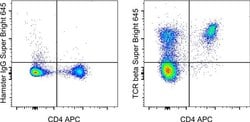Learn More
Invitrogen™ TCR beta Monoclonal Antibody (H57-597), Super Bright™ 645, eBioscience™
Armenian Hamster Monoclonal Antibody
Supplier: Invitrogen™ 64596182

Description
Description: The H57-597 monoclonal antibody reacts with the beta chain of mouse TCR. TCR beta is expressed by thymocytes in a developmentally regulated manner and a majority of peripheral T cells. Crosslinking of the TCR complex with H57-597 induces activation and proliferation of T cells or apoptosis based on assay conditions. H57-597 is used as a phenotypic marker for TCR beta expressing T cells. Applications Reported: This H57-597 antibody has been reported for use in flow cytometric analysis. Applications Tested: This H57-597 antibody has been tested by flow cytometric analysis of mouse splenocytes. This may be used at less than or equal to 0.5 μg per test. A test is defined as the amount (μg) of antibody that will stain a cell sample in a final volume of 100 μL. Cell number should be determined empirically but can range from 10^5 to 10^8 cells/test. It is recommended that the antibody be carefully titrated for optimal performance in the assay of interest. Super Bright 645 is a tandem dye that can be excited with the violet laser line (405 nm) and emits at 645 nm. We recommend using a 660/20 bandpass filter. Please make sure that your instrument is capable of detecting this fluorochrome. When using two or more Super Bright dye-conjugated antibodies in a staining panel, it is recommended to use Super Bright Complete Staining Buffer (Product # SB-4401) to minimize any non-specific polymer interactions. Please refer to the datasheet for Super Bright Staining Buf...
The ability of T cell receptors (TCR) to discriminate foreign from self-peptides presented by major histocompatibility complex (MHC) class II molecules is essential for an effective adaptive immune response. TCR recognition of self-peptides has been linked to autoimmune disease. Mutant self-peptides have been associated with tumors. Engagement of TCRs by a family of bacterial toxins know as superantigens has been responsible for toxic shock syndrome. Autoantibodies to V beta segments of T cell receptors have been isolated from patients with rheumatoid arthritis (RA) and systemic lupus erythematosus (SLE). The autoantibodies block TH1-mediated inflammatory autodestructive reactions and are believed to be a method by which the immune system compensates for disease (ref5). T Cell and TCR Diversity Most human T cells express the TCR alpha-beta and either CD4 or CD8 molecule (single positive, SP). A small number of T cells lack both CD4 and CD8 (double negative, DN). Increased percentages of alpha-beta DN T cells have been identified in some autoimmune and immunodeficiency disorders. Gamma-delta T cells are primarily found within the epithelium. They show less TCR diversity and recognize antigens differently than alpha-beta T cells. Subsets of gamma-delta T cells have shown antitumor and immunoregulatory activity.
Specifications
| TCR beta | |
| Monoclonal | |
| 0.2 mg/mL | |
| PBS with BSA and 0.09% sodium azide; pH 7.2 | |
| 0 | |
| Tcrb | |
| Affinity chromatography | |
| RUO | |
| 21577 | |
| 4°C, store in dark, DO NOT FREEZE! | |
| Liquid |
| Flow Cytometry | |
| H57-597 | |
| Super Bright 645 | |
| Tcrb | |
| bTCR; FLJ22602; MGC117436; MGC22624; MGC23964; MGC71411; T cell receptor beta chain; t-cell antigen receptor; T-cell receptor; TCR beta; Tcra; Tcrb; TCRbeta; TCRD; Tib; TRA | |
| Armenian Hamster | |
| 100 μg | |
| Primary | |
| Mouse | |
| Antibody | |
| IgG |
Safety and Handling
The Fisher Scientific Encompass Program offers items which are not part of our distribution portfolio. These products typically do not have pictures or detailed descriptions. However, we are committed to improving your shopping experience. Please use the form below to provide feedback related to the content on this product.
